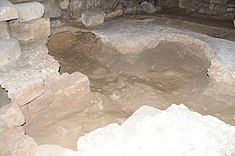Monastery of Dumio
| Monastery of Dumio (Mosteiro de Dumio) | |
| Archaeological Ruins of São Martinho of Dume | |
| Monastery (Mosteiro) | |
| Official name: Ruínas Arqueológicas de São Martinho de Dume | |
| Name origin: são martinho de dumio Portuguese for Saint Martin of Braga of Dume | |
| Country | |
|---|---|
| Region | Norte |
| Sub-region | Cávado |
| District | Braga |
| Municipality | Braga |
| Location | Dume |
| - elevation | 91 m (299 ft) |
| - coordinates | 41°34′1.68″N 8°26′8.03″W / 41.5671333°N 8.4355639°WCoordinates: 41°34′1.68″N 8°26′8.03″W / 41.5671333°N 8.4355639°W |
| Origin | 1st century |
| - Initiated | 6th century |
| - Completion | 6th century |
| Re-discovered | 1987 |
| Owner | Roman Catholic Archdiocese of Braga, Portuguese Republic |
| For public | Public |
| Easiest access | Lugar da Igreja, Lugar do Assento |
| Management | Instituto Gestão do Patrimonio Arquitectónico e Arqueológico |
| Status | National Monument |
| Listing | Decree No.45/93, 30 Novembro 1993 |
The Monastery of Dumio (sometimes Dumium or Dumio, in Portuguese São Martinho de Dume), is a former paleo-Christian monastery in the civil parish of Dume, municipality of Braga, in northwestern Portugal. Originally a Roman villa, it was the base of a basilica by Suebi tribes, and later Christian monastery headed by Martin of Braga in the 6th century (c. 550–560). The re-discovery of the Roman ruins in the late 20th century resulted in archaeological excavations that unearthed its former use.
By the 1st century, there already existed an octagonal Roman villa, which, much later (3rd century) included a system of baths.
In the first half of the 6th century, construction of a primitive church was ordered constructed by the Suebi King Chararic (Suebian king), to honour God for curing his son. It can also be inferred that this was a reflection of the expansion and authority of the Suebi within the northern context of Braga. By the middle of the 6th century, the site began to take on an important context within the peninsula. Under Martin of Braga, referred to as the Apostle of the Suebi, the older structures were taken over by a monastery, whose religious importance began to make it the centre of religion in the kingdom, and an autonomous diocese in close proximity to Braga. The King himself constructed a palace annex, making the ancient village a centre of decision-making in the Cortes. The design was also a combination of Suebi aesthetics and 6th century influences from southern Gaul; there existed semi-formal links to the Merovingian monarchs with whom the Suebi corresponded, showing artistic influences in the sarcophagus and layout of the basilica.
Three centuries after the construction of São Martinho, and during the Reconquista the basilica was the object of fundamental reforms. The church was transferred to the benevolance of the Bishop of Mondonhedo, São Rosendo (later confirmed in 911).
...
Wikipedia

